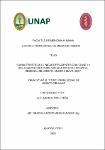Características de pacientes con COVID-19 que usaron corticoides inhalados en el Hospital Regional de Loreto, enero a mayo, 2021
Abstract
Objective: To determine the clinical characteristics of patients with COVID-19 who used inhaled corticosteroids at the Regional Hospital of Loreto, January to May, 2021.
Methodology and materials: An observational, retrospective, cross-sectional and analytical study of patients hospitalized for COVID-19 from January to May 2021 was carried out. There were 731 medical records, using exclusion criteria, a total of 257 records were obtained, in which it was found two groups of patients: those who used inhaled corticosteroids (ICS) (n=155) and those who did not use ICS (n=102). Sociodemographic data, comorbidities, symptoms, complications and outcome were extracted; these were evaluated using tables of frequency, standard deviation and mean; Chi-square was used to analyze the association of categorical variables, and Mann-Whitney U was used for quantitative variables.
Results: The mean age of the patients who used ICs was 56.34 years (IQR: 21–91); mostly male (58.4%), the mean time of illness and hospital stay of those who used ICs was higher by 0.73 (9.23 vs 8.5) and 1.03 (8. 55 vs 7.52) days, respectively, of those who did not use ICs. 60.3% (n=155) used ICs during their hospitalization, with a mean time of use of 3.79 days, of which the majority used less than 7 days (56.8%). Among the most used CIs, Beclomethasone was found in 153 (98.7%), with an average dose of 1380.72 ug/day. The time of illness and hospital stay were significantly associated with the use of ICs. Comorbidities, complications, and mortality were not significantly associated with the use of ICs.
Conclusion: The time of illness and hospital stay were significantly associated with the use of ICs. The outcome and the use of ICs were not significantly associated, with which it is concluded that the use of ICs would not influence the mortality of patients with COVID-19 who used ICs. Objetivo: Determinar las características clínicas de pacientes con COVID-19 que usaron corticoides inhalados en el Hospital Regional de Loreto, enero a mayo, 2021.
Metodología y materiales: Se realizó un estudio observacional, retrospectivo, transversal y analítico de pacientes hospitalizados por COVID-19 de enero a mayo del 2021. Se contó con 731 historias clínicas, mediante criterios de exclusión, se obtuvo un total de 257 historias, en las cuales se encontró dos grupos de pacientes: que usaron corticoides inhalados (CIs) (n=155) y que no usaron CIs (n=102). Se extrajeron datos sociodemográficos, comorbilidades, síntomas, complicaciones y desenlace; estos fueron evaluados mediante tablas de frecuencia, desviación estándar y media; para analizar la asociación de las variables categóricas se usó Chi-cuadrado y para las variables cuantitativas se utilizó U de Mann-Whitney.
Resultados: La media de edad de los pacientes que usaron CIs fue 56,34 años (RIQ:21–91); en su mayoría del sexo masculino (58,4%), la media del tiempo de enfermedad y la estancia hospitalaria de los que usaron CIs fue superior en 0,73 (9,23 vs 8,5) y 1,03 (8,55 vs 7,52) días respectivamente, de los que no usaron CIs. El 60,3 % (n=155) utilizó CIs durante su hospitalización, con una media de tiempo de uso de 3,79 días, de las cuales la mayoría utilizó menos de 7 días (56,8%). Entre los CIs más utilizados, se encontró Beclometasona en 153 (98,7%), con una dosis promedio de 1380,72 ug/día. El tiempo de enfermedad y la estancia hospitalaria, se asociaron significativamente con el uso de CIs. Las comorbilidades, complicaciones y mortalidad no se asociaron significativamente con el uso de CIs.
Conclusión: El tiempo de enfermedad y la estancia hospitalaria se asoció significativamente con el uso de CIs. El desenlace y el uso de CIs no se asociaron significativamente, con lo que se concluye que el uso de CIs no influiría en la mortalidad de los pacientes con COVID-19 que usaron CIs.
Collections
- Tesis [367]


